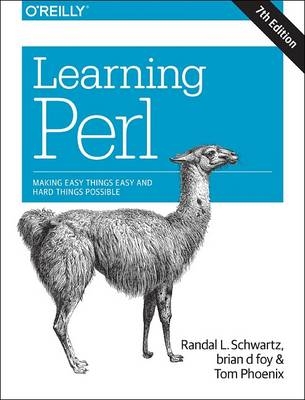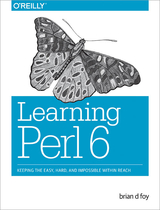
Learning Perl
O'Reilly Media (Verlag)
978-1-4919-5432-4 (ISBN)
- Titel ist leider vergriffen;
keine Neuauflage - Artikel merken
Perl is suitable for almost any task on almost any platform, from short fixes to complete web applications. Learning Perl teaches you the basics and shows you how to write programs up to 128 lines long—roughly the size of 90% of the Perl programs in use today.
Each chapter includes exercises to help you practice what you’ve just learned. Other books may teach you to program in Perl, but this book will turn you into a Perl programmer.
Topics include:
Perl data and variable types
Subroutines
File operations
Regular expressions
String manipulation (including Unicode)
Lists and sorting
Process management
Smart matching
Use of third party modules
brian d foy is a prolific Perl trainer and writer, and runs The Perl Review to help people use and understand Perl through educational, consulting, code review, and more. He's a frequent speaker at Perl conferences. He's the co-author of Learning Perl, Intermediate Perl, and Effective Perl Programming, and the author of Mastering Perl. He was been an instructor and author for Stonehenge Consulting Services from 1998 to 2009, a Perl user since he was a physics graduate student, and a die-hard Mac user since he first owned a computer. He founded the first Perl user group, the New York Perl Mongers, as well as the Perl advocacy nonprofit Perl Mongers, Inc., which helped form more than 200 Perl user groups across the globe. He maintains the perlfaq portions of the core Perl documentation, several modules on CPAN, and some stand-alone scripts.
Randal L. Schwartz is a two-decade veteran of the software industry. He is skilled in software design, system administration, security, technical writing, and training. Randal has coauthored the "must-have" standards: Programming Perl, Learning Perl, Learning Perl for Win32 Systems, and Effective Perl Learning, and is a regular columnist for WebTechniques, PerformanceComputing, SysAdmin, and Linux magazines. He is also a frequent contributor to the Perl newsgroups, and has moderated comp.lang.perl.announce since its inception. His offbeat humor and technical mastery have reached legendary proportions worldwide (but he probably started some of those legends himself). Randal's desire to give back to the Perl community inspired him to help create and provide initial funding for The Perl Institute. He is also a founding board member of the Perl Mongers (perl.org), the worldwide Perl grassroots advocacy organization. Since 1985, Randal has owned and operated Stonehenge Consulting Services, Inc. Randal can be reached for comment at merlyn@stonehenge.com or (503) 777-0095, and welcomes questions on Perl and other related topics.
Tom Phoenix has been working in the field of education since 1982. After more than thirteen years of dissections, explosions, work with interesting animals, and high-voltage sparks during his work at a science museum, he started teaching Perl classes for Stonehenge Consulting Services, where he's worked since 1996. Since then, he has traveled to many interesting locations, so you might see him soon at a Perl Mongers' meeting. When he has time, he answers questions on Usenet's comp.lang.perl.misc and comp.lang.perl.moderated newsgroups, and contributes to the development and usefulness of Perl. Besides his work with Perl, Perl hackers, and related topics, Tom spends his time on amateur cryptography and speaking Esperanto. His home is in Portland, Oregon.
Chapter 1Introduction
Questions and Answers
What Does “Perl” Stand For?
How Can I Get Perl?
How Do I Make a Perl Program?
A Whirlwind Tour of Perl
Exercises
Chapter 2Scalar Data
Numbers
Strings
Perl’s Built-In Warnings
Scalar Variables
Output with print
The if Control Structure
Getting User Input
The chomp Operator
The while Control Structure
The undef Value
The defined Function
Exercises
Chapter 3Lists and Arrays
Accessing Elements of an Array
Special Array Indices
List Literals
List Assignment
Interpolating Arrays into Strings
The foreach Control Structure
Scalar and List Context
Exercises
Chapter 4Subroutines
Defining a Subroutine
Invoking a Subroutine
Return Values
Arguments
Private Variables in Subroutines
Variable-Length Parameter Lists
Notes on Lexical (my) Variables
The use strict Pragma
The return Operator
Nonscalar Return Values
Persistent, Private Variables
Subroutine Signatures
Exercises
Chapter 5Input and Output
Input from Standard Input
Input from the Diamond Operator
The Invocation Arguments
Output to Standard Output
Formatted Output with printf
Filehandles
Opening a Filehandle
Fatal Errors with die
Using Filehandles
Reopening a Standard Filehandle
Output with say
Filehandles in a Scalar
Exercises
Chapter 6Hashes
What Is a Hash?
Hash Element Access
Hash Functions
Typical Use of a Hash
The %ENV hash
Exercises
Chapter 7Regular Expressions
Sequences
Practice Some Patterns
The Wildcard
Quantifiers
Grouping in Patterns
Alternatives
Character Classes
Unicode Properties
Anchors
Exercises
Chapter 8Matching with Regular Expressions
Matches with m//
Match Modifiers
The Binding Operator =~
The Match Variables
Precedence
A Pattern Test Program
Exercises
Chapter 9Processing Text with Regular Expressions
Substitutions with s///
The split Operator
The join Function
m// in List Context
More Powerful Regular Expressions
Exercises
Chapter 10More Control Structures
The unless Control Structure
The until Control Structure
Statement Modifiers
The Naked Block Control Structure
The elsif Clause
Autoincrement and Autodecrement
The for Control Structure
Loop Controls
The Conditional Operator
Logical Operators
Exercises
Chapter 11Perl Modules
Finding Modules
Installing Modules
Using Simple Modules
Exercises
Chapter 12File Tests
File Test Operators
The stat and lstat Functions
The localtime Function
Bitwise Operators
Exercises
Chapter 13Directory Operations
The Current Working Directory
Changing the Directory
Globbing
An Alternate Syntax for Globbing
Directory Handles
Manipulating Files and Directories
Removing Files
Renaming Files
Links and Files
Making and Removing Directories
Modifying Permissions
Changing Ownership
Changing Timestamps
Exercises
Chapter 14Strings and Sorting
Finding a Substring with index
Manipulating a Substring with substr
Formatting Data with sprintf
Advanced Sorting
Exercises
Chapter 15Process Management
The system Function
The Environment Variables
The exec Function
Using Backquotes to Capture Output
External Processes with IPC::System::Simple
Processes as Filehandles
Getting Down and Dirty with Fork
Sending and Receiving Signals
Exercises
Chapter 16Some Advanced Perl Techniques
Slices
Trapping Errors
Picking Items from a List with grep
Transforming Items from a List with map
Fancier List Utilities
Exercises
Appendix Exercise Answers
Answers to Chapter 1 Exercises
Answers to Chapter 2 Exercises
Answers to Chapter 3 Exercises
Answers to Chapter 4 Exercises
Answers to Chapter 5 Exercises
Answers to Chapter 6 Exercises
Answers to Chapter 7 Exercises
Answers to Chapter 8 Exercises
Answers to Chapter 9 Exercises
Answers to Chapter 10 Exercises
Answers to Chapter 11 Exercises
Answers to Chapter 12 Exercises
Answers to Chapter 13 Exercises
Answers to Chapter 14 Exercises
Answers to Chapter 15 Exercises
Answers to Chapter 16 Exercises
Appendix Beyond the Llama
Further Documentation
Regular Expressions
Packages
Extending Perl’s Functionality
Databases
Mathematics
Lists and Arrays
Bits and Pieces
Formats
Networking and IPC
Security
Debugging
Command-Line Options
Built-In Variables
References
Tied Variables
Operator Overloading
Using Other Languages Inside Perl
Embedding
Converting find Command Lines to Perl
Command-Line Options in Your Programs
Embedded Documentation
More Ways to Open Filehandles
Graphical User Interfaces (GUIs)
And More…
Appendix A Unicode Primer
Unicode
UTF‑8 and Friends
Getting Everyone to Agree
Fancy Characters
Dealing with Unicode in Perl
Further Reading
Appendix Experimental Features
A Short History of Perl Development
Installing a Recent Perl
Experimental Features
| Erscheinungsdatum | 04.10.2016 |
|---|---|
| Zusatzinfo | black & white illustrations |
| Verlagsort | Sebastopol |
| Sprache | englisch |
| Maße | 150 x 250 mm |
| Gewicht | 666 g |
| Einbandart | kartoniert |
| Themenwelt | Informatik ► Programmiersprachen / -werkzeuge ► Perl |
| Mathematik / Informatik ► Informatik ► Web / Internet | |
| Schlagworte | Book • Buch • Einstieg • Lama • Lehrbuch • Lernen • Llama • Perl • Programmieren • Programmiersprache |
| ISBN-10 | 1-4919-5432-9 / 1491954329 |
| ISBN-13 | 978-1-4919-5432-4 / 9781491954324 |
| Zustand | Neuware |
| Informationen gemäß Produktsicherheitsverordnung (GPSR) | |
| Haben Sie eine Frage zum Produkt? |
